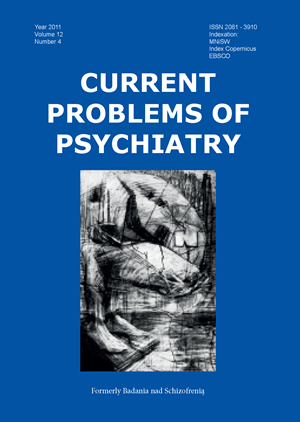CT perfusion of the brain – what is its role today and expectancies for tomorrow?
Słowa kluczowe:
perfuzja, TK, mózg, udarAbstrakt
Perfuzja tomografii komputerowej (CTP) dostarcza dodatkowych informacji o miejscowych parametrach hemodynamicznych mózgu w różnych chorobach OUN. Równolegle z rozwijającą się technologią tomografii komputerowej, obserwuje się intensywny rozwój perfuzji TK, związany z ekspansją tomografów wielorzędowych (cztery do 320-rzędów) oraz zwiększeniem szerokości detektorów. Celem tej pracy jest omówienie najnowszych możliwości perfuzji tomografii komputerowej w obrazowaniu różnych chorób mózgu oraz dyskusja nad kierunkami rozwoju perfuzji TK w przyszłości.
Bibliografia
1. Orrison W.W. Jr., Snyder K.V., Hopkins L.N. et al. Whole-brain dynamic CT angiography and perfusion imaging. Clin. Radiol., 2011; 66: 566-574.
2. Dorn F., Muenzel D., Meier R. et al. Brain perfusion CT for acute stroke using a 256-slice CT: improvement of diagnostic information by large volume coverage. Eur. Radiol. 2011; 21:1803–1810.
3. Roberts H.C., Roberts T.P., Smith W.S. et al. Multisection dynamic CT perfusion for acute cerebral ischemia: the “toggling-table” technique. AJNR Am. J. Neuroradiol. 2011; 22:1077–1080.
4. Murayama K., Katada K., Nakane M et al. Whole-brain perfusion CT performed with a prototype 256-detector row CT system: initial experience. Radiology; 2009; 250:202–211.
5. Siebert E., Bohner G., Dewey M. et al. 320-slice CT neuroimaging: initial clinical experience and image quality evaluation. Br. J. Radiol., 2009; 82:561–570.
6. Page M., Nandurkar D., Crossett M.P. et al. Comparison of 4 cm Z-axis and 16 cm Z-axis multidetector CT perfusion. Eur. Radiol., 2010; 20:1508–1514.
7. Rosamond W., Flegal K., Furie K. et al. Heart disease and stroke statistics—2008 update: a report from the American Heart Association Statistics Committee and Stroke Statistics Subcommittee. Circulation, 2008; 117:e25–e146.
8. Truelsen T., Piechowski-Jozwiak B., Bonita R. et al. Stroke incidence and prevalence in Europe: a review of available data. Eur. J. Neurol., 2006; 13: 581–598.
9. Schellinger P.D., Fiebach J.B., Mohr A. et al. Thrombolytic therapy for ischemic stroke–a review. Part I—Intravenous thrombolysis. Crit. Care Med., 2001; 29:1812–1818.
10. Wintermark M. Brain perfusion-CT in acute stroke patients. Eur. Radiol., 2005; 15 (Suppl. 4):D28–D31.
11. Lövblad K.O., Baird A.E. Computed tomography in acute ischemic stroke. Neuroradiology, 2010; 52:175–187.
12. Soares B.P., Dankbaar J.W., Bredno J. et al. Automated versus manual post-processing of perfusion-CT data in patients with acute cerebral ischemia: influence on interobserver variability. Neuroradiology, 2009; 51:445–451.
13. Silvernnoinen H.M., Hamberg L.M., Lindberg P.J. et al. CT Perfusion identifies increased salvage of tissue in patients receiving intravenous recombinant tissue plasminogen activator within 3 hours of stroke onset. AJNR Am. J. Neuroradiol., 2008; 29:1118–1123.
14. Kazufumi S., Satoru M., Ai M. et al. Utility of CT perfusion with 64-row multi-detector CT for acute ischemic brain stroke. Emerg. Radiol., 2011; 18:95–101.
15. Darwish R.S., Amiridze N.S. Brain perfusion abnormalities in patients with compromised venous outflow. J. Neurol., 2011; 258:1445–1450.
16. Sanelli P.C., Jou A., Gold R. et al. Using CT perfusion during the early baseline period in aneurysmal subarachnoid hemorrhage to assess for development of vasospasm. Neuroradiology, 2011; 53:425–434.
17. Nabavi D.G., LeBlanc L.M., Baxter B. et al. Monitoring cerebral perfusion after subarachnoid hemorrhage using CT. Neuroradiology, 2001; 43:7–16.
18. Lie C.H., Seifert M., Poggenborg J. et al. Perfusion computer tomography helps to differentiate seizure and stroke in acute setting. Clin. Neurol. and Neurosurgery, 2011; 113: 925–927.
19. Bussière M., Pelz D., Reid R.H., Young G.B. Prolonged deficits after focal inhibitory seizures. Neurocrit. Care, 2005; 2(1):29–37.
20. Schramm P., Xyda A., Klotz E. et al. Dynamic CT perfusion imaging of intra-axial brain tumours: differentiation of high-grade gliomas from primary CNS lymphomas. Eur. Radiol., 2010; 20: 2482–2490.
21. Zimny A., Sasiadek M., Leszek J. et al. Does perfusion CT enable differentiating Alzheimer's disease from vascular dementia and mixed dementia? A preliminary report. J. of the Neurol. Sci., 2007; 257: 114– 120.
Pobrania
Opublikowane
Numer
Dział
Licencja
Prawa autorskie (c) 2011 Autorzy

Praca jest udostępniana na licencji Creative Commons Attribution-NonCommercial-NoDerivatives 3.0 Unported License.


